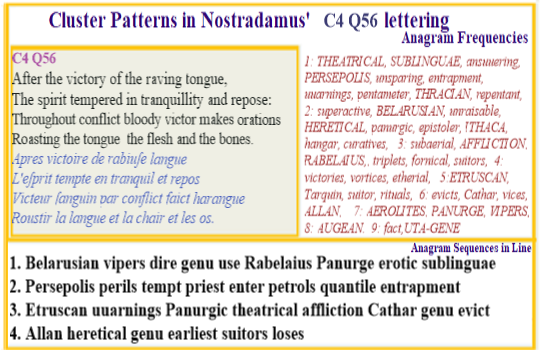 Analyses of all verses
Analyses of all verses
|
 Web Site
Web Site |
 All
Sefirots All
Sefirots |
Nostradamus C4 Q56: Rabelaius'
allegory of giants involved in war around the Mediterranean Seas.
Copyright: Allan Webber, December 2015
 The anagrams in
this verse point to Rabelaius
a contemporary figure of Nostradamus time.
The anagrams in
this verse point to Rabelaius
a contemporary figure of Nostradamus time.
There are other anagrams-of names that reach back to the 6th century BCE and forward to our modern times.
Rabelaius (rabiuſe la) and and his fictional hero, Panurge (ngue Apr), occur as adjacent anagrams in the first line.
This latter name is backed by an anagram for Panurgic (guin par c) in the third.
Not only do these rare anagrams appear together in the same verse but the tone of this verse seems to tie to the following the adventures of the giant Pantagruel in which a body is dismembered and the parts such as the head are desecrated.
C4 Q 56: After the victory of the raving tongue,
The spirit tempered in tranquillity and repose:
Throughout the conflict the bloody victor makes orations
Roasting the tongue and the flesh and the bones.
Now Rabelaius and Nostradamus were contemporaries with both being residence of Southern France and they may well have attended Montpellier university at the same time, so to find such references should come as no real surprise.